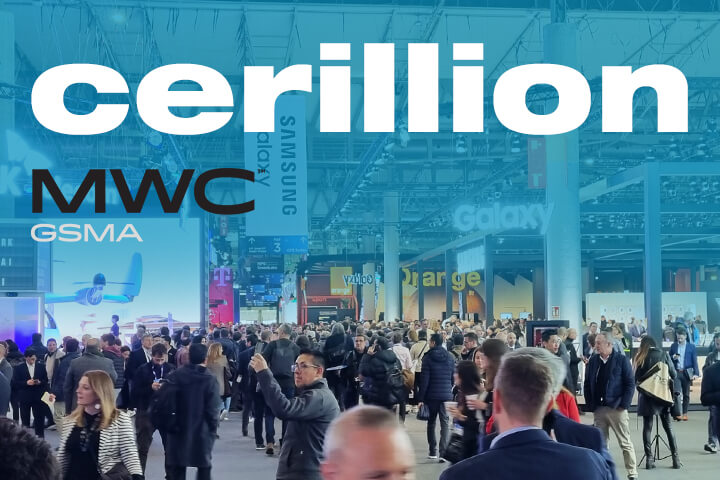MWC 2023: A mixed bag of innovation and hype

MWC is back, but did it deliver? Cerillion’s Product Director, Brian Coombs, picks out the highlights (and lowlights) from four days of roaming around the cavernous exhibition halls.
As usual, MWC 2023 promised to showcase the latest innovations and leading-edge technology from more than 2,400 companies and nearly 90,000 visitors. I know it never actually went away, but the last two years have definitely been a different MWC Barcelona. This year though, it was back, and it was buzzing!
Cerillion was back too, showcasing our latest product release and using ChatGPT to demonstrate our charging solution. This created quite a buzz around our stand as people saw how we integrated ChatGPT’s natural language processing capabilities with our Convergent Charging System via its REST APIs. This simple but powerful demonstration showed how if your charging engine is modern and flexible enough, you can charge for pretty much anything.
6G (yes, you read that right!) was one of the more hyped-up attractions at MWC 2023, with the first 6G demo from NTT Docomo, Japan's largest mobile operator. Impressive? Maybe. Relevant? Not really. The industry is still struggling to roll out 5G networks and services across the world, so do we really need to jump ahead to something that is at least a decade away from commercialisation just yet? If 5G was fast enough for remote surgery demos, then Docomo’s Human Augmentation Platform, making it possible to transmit haptic feedback to someone sitting next to you while playing an instrument, felt more like a publicity stunt than a genuine breakthrough.
There was a definite increase in country and region stands this year, reflecting the growing diversity and fragmentation of the mobile industry, as well as the need for collaboration and support among smaller players. Some of these stands had interesting innovations to offer, while others were just trying to get some exposure. Generally, though, it made an already almost overwhelming show even more so.
The standout new tech on display at MWC 2023 for me was undoubtedly the ZTE Nubia Pad 3D, a tablet that can project 3D images without glasses or headsets. Using an advanced light field display technology, the device creates an illusion of depth and realism for the viewer by tracking their eye movements and adjusting the picture to match.
It was truly amazing to see how lifelike and immersive the images were on this device, whether it was a movie trailer, a video game (the dungeon crawler being a particular highlight) or a virtual tour. Surprisingly inexpensive and available now in some parts of the world, this is very tempting – the only caveat is that it did give some people eye aches after prolonged use, so try before you buy.
Other bits of tech that stood out included: the full size hyperloop capsule, demonstrating their plans for hyperloop ports; the exoskeleton suit that was allowing a man whose spine had been severed to walk again, listening to him talk about how it had changed his life was quite inspiring; robot arms were everywhere, serving coffee, picking things up and moving them around; and there were the now obligatory Boston Dynamics dogs wandering around and many generic standing robots with people shouting at them trying to be heard over the background noise of the show.
On the device front, we are still mostly in the black slab of glass times, but one of the trends that caught my eye at MWC 2023 was night pictures – or rather, how mobile phone cameras have improved their performance in low-light conditions. Several manufacturers showcased their new models with enhanced night modes that can capture stunning photos even in pitch dark scenarios. They used various techniques such as AI algorithms, optical image stabilisation, large sensors, and multiple lenses to achieve this feat.
One device in particular that intrigued me was Motorola’s rollable prototype – a phone that can expand into a taller form factor by unrolling its flexible screen. The device looked sleek and futuristic, but, like the foldables a few years back, it was locked away in a glass box, so its durability and practicality is yet to be proven. It seemed like an example of where the form factor might go in a couple of years, but not something I would expect to be buying anytime soon.
Sustainability was also a big theme for 2023, with many exhibitors showcasing their green initiatives and solutions for reducing carbon emissions. One noticeable trend was the shift from cars to bikes as the preferred mode of transportation for urban mobility. There were fewer cars on display than previous years (except for Tesla), but more bikes (and scooters) from various brands and startups. Some were electric-powered, some were foldable or modular, most were smart or connected – but all of them aimed to make cycling more convenient, safe, and fun. Segway in particular seemed to be making a push to expand its offerings here.
Finally, one thing that continued to confuse me at MWC was how much time and money is being wasted by different companies all competing to create a multiverse that no-one will use. You name it – they all had their own versions of VR, AR or extended reality (XR) platforms that promised to connect users across different worlds and experiences. But will people really want to spend a load of time in these artificial realities? And if so, which one? How will we ensure interoperability and security among different metaverses? And who will own and control them? I think these companies are missing the point of what people really want from technology: convenience, simplicity, and authenticity.
If the last few years of disruption have taught us anything, it’s that there’s no substitute for real human interaction – and that’s why nearly 90,000 people returned to Barcelona to do it face-to-face.

